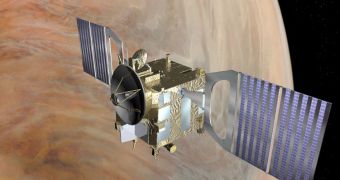The Venus Express orbiter has recently sent back some datasets that made researchers wonder as to whether our neighboring planet may indeed hold clues to Earth's climate future. The spacecraft found peculiar sulfur dioxide clouds lurking at high altitudes above the planet's surface.
The probe, operated by the European Space Agency (ESA), relays a warning to experts promoting certain types of geoengineering here on Earth, scientists say.
These experts are currently promoting the idea that injecting sulfur droplets into the atmosphere would contribute to global cooling, by reducing the amount of heat trapped in the air, and bouncing back more sunlight into space.
[ADMARK=1It was very interesting for ESA experts to peer over the new data, especially in light of established knowledge on how the sulfur cycle of Venus functions and regulates itself.
At heights of up to 50-70 kilometers, sulfur dioxide particles originating from volcanoes combine with water vapor to produce sulfuric acid, which then aggregates into droplets. The remaining sulfur dioxide is eliminated by strong solar winds sweeping the planet.
Until now, experts were convinced that this was the entire extent of the sulfur cycle. But Venus Express data showed that SO2 clouds formed at altitudes of 90 to 110 kilometers as well.
Recently, a team of researchers from the United States, France and Taiwan, led by California Institute of Technology (Caltech) researcher Xi Zhang, developed a new compute simulation to explain what happens on the planet,
The group says that a part of the sulphuric acid droplets that form from water and volcanic particles tend to evaporate when they reach higher altitudes, producing gaseous sulphuric acid in the process.
When sunlight interacts with the gas, it forces it to release back sulfur dioxide gas. “We had not expected the high-altitude sulfur layer, but now we can explain our measurements,” says Håkan Svedhem.
The expert holds an appointment as a Venus Express project scientist at ESA. “However, the new findings also mean that the atmospheric sulfur cycle is more complicated than we thought,” he adds.
Injecting sulfur particles into Earth's atmosphere is something that needs to be studied in great detail, researchers say, due to the large number of negative consequences that can arise from its use.
“We must study in great detail the potential consequences of such an artificial sulfur layer in the atmosphere of Earth,” explains researcher Jean-Loup Bertaux.
The Université de Versailles-Saint-Quentin expert is the principal investigator of SPICAV (Spectroscopy for Investigation of Characteristics of the Atmosphere of Venus) instrument on the ESA orbiter.
“Venus has an enormous layer of such droplets, so anything that we learn about those clouds is likely to be relevant to any geoengineering of our own planet,” he adds.

 14 DAY TRIAL //
14 DAY TRIAL //